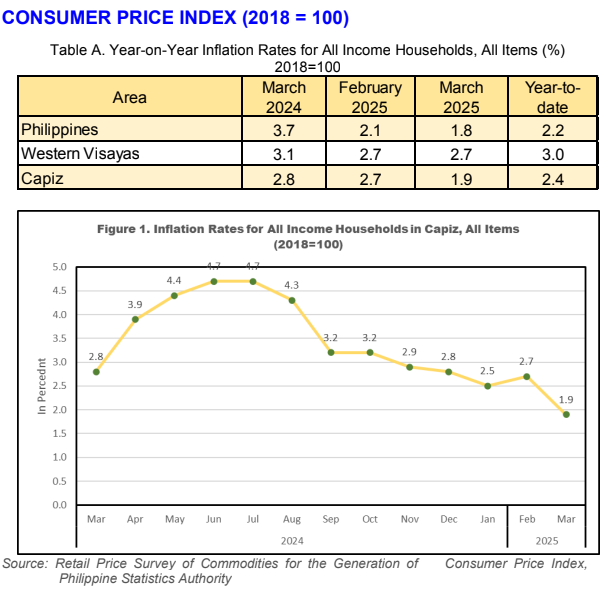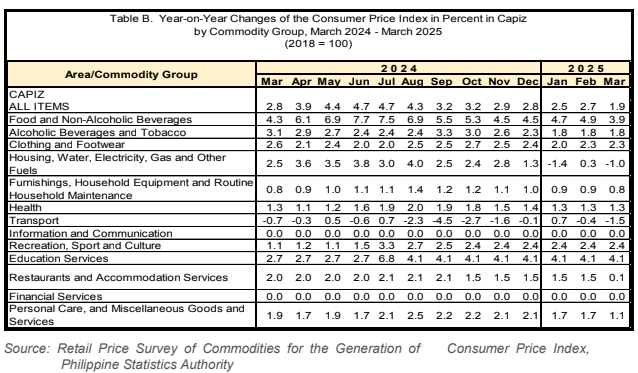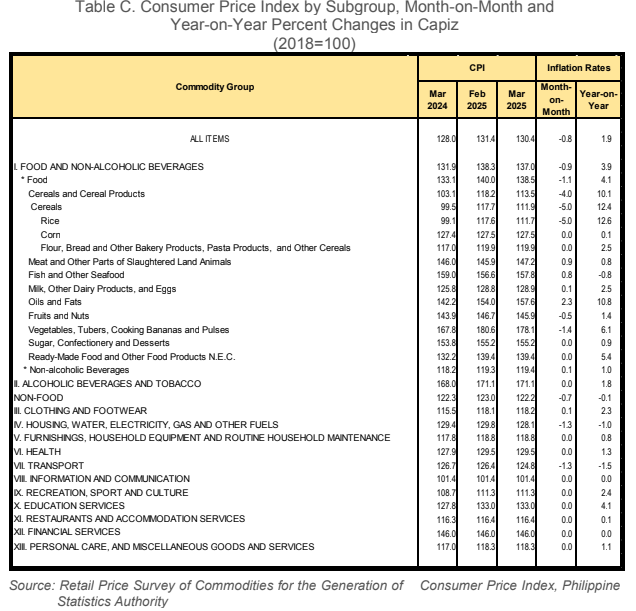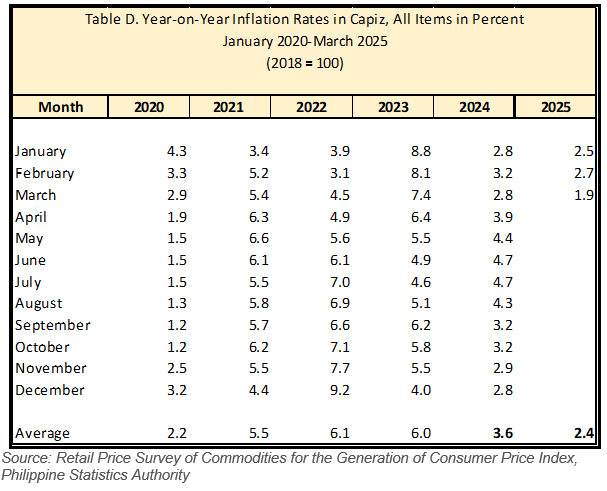
In March 2025, the headline inflation rate in the province of Capiz decreased to 1.9percent, down from 2.7 percent the previous month. This marks the lowest inflationrate recorded in the last twenty-four months since the base year was revised to 2018.In comparison, the inflation rate for March 2024 was notably higher at 2.8 percent. The overall average inflation rate for Capiz throughout the year is 2.4 percent. In contrast, the average inflation rate for the Western Visayas region stands at 3.0 percent, which is 0.8 percent above the national average inflation rate of 2.2 percent (refer to Figure 1, Table A, and Table D).
The decline in inflation in Capiz can be attributed to a decrease in the heavily weighted category of Food and Non-Alcoholic Beverages, which fell from 4.9 percent in February to 3.9 percent in March 2025. Additionally, the Housing, Water, Electricity, Gas, and Other Fuels category dropped from 0.3 percent in February 2025 to -1.0 percent in March 2025. The inflation rate for Restaurants and Accommodation Services also decreased, from 1.5 percent in February 2025 to 0.1 percent in March 2025. Moreover, Transport saw a steady decline, dropping from -0.4 percent in February 2025 to -1.5 percent in March 2025. The Personal Care and Miscellaneous Goods and Services category experienced a decrease as well, falling from 1.7 percent in February 2025 to 1.1 percent in March 2025. Other commodity categories showed minimal changes or remained stable during this period (see Table B and Table C).

The following non-food commodity groups maintained their previous marks during the period such as:
1. Alcoholic Beverages and Tobacco, 1.8 percent vs 1.8
2. Clothing and Footwear, 2.3 percent vs 2.3
3. Health, 1.3 percent vs 1.3
4. Information and Communication, 0.0 percent vs 0.0
5. Recreation, Sport and Culture, 2.4 percent vs 2.4
6. Education Services, 4.1 vs 4.1
7. Financial Services, 0.0 percent vs 0.0

The most significant decrease in the Food and Non-Alcoholic Commodity Group occurred in the Rice category, which dropped from 21.9 percent in February 2025 to 12.6 percent in March 2025. Similarly, the Vegetables, Tubers, Cooking Bananas, and Pulses category experienced a decline, falling from 7.0 percent to 6.1 percent during the same period. Additionally, the price of Ready-Made Food and Other Food Products not elsewhere classified (NEC) also saw a slight decrease, dropping from 5.8 percent in February 2025 to 5.4 percent in March 2025.
Conversely, several food commodities within this index group experienced a slight increase in prices. Most notably, the price of Fish and Other Seafood rose from -3.3 percent in February 2025 to -0.8 percent in March 2025. Similarly, the prices of Oils and Fats increased from 8.3 percent in February 2025 to 10.8 percent in March 2025. Additionally, Sugar, Confectionery, and Desserts registered a rise, climbing from -0.1 percent in February 2025 to 0.9 percent in March 2025 (see Table C).
The annual rate for non-alcoholic beverages slightly increased from 0.9 percent in February 2025 to 1.0 percent in March 2025. In contrast, the rate for alcoholic beverages and tobacco remained unchanged at 1.8 percent in March 2025, the same as the previous month (see Table C).
Additionally, several food groups experienced rising inflation compared to the previous month:
1. Meat and Other Parts of Slaughtered Land Animals, -0.1 percent vs. 0.8 percent
2. Fruits and Nuts, 0.6 percent vs. 1.4 percent
3. Milk, Other Dairy Products, and Eggs, 2.4 percent vs. 2.5 percent


